解决 macOS Sierra 问题
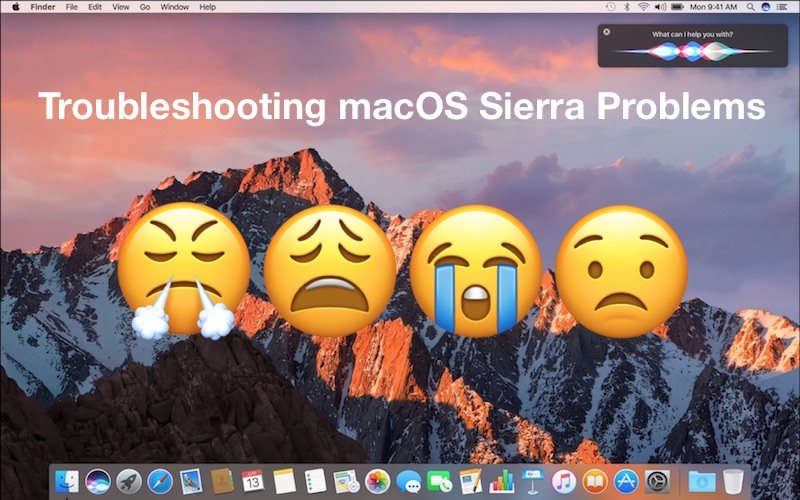
For most users, installing macOS Sierra has gone without a hitch and they’re left with a trouble-free Mac that works great with the latest macOS system software release. But, not everything goes smoothly for everyone, and sometimes updating to macOS Sierra can lead to a variety of problems.
We’re compiling a list of common problems in this troubleshooting guide to remedy issues with the macOS Sierra download, installation, update, and post-install process. Unfortunately for me (but fortunately for you readers), I personally have had the joy of encountering many of these problems during and after updating one particular MacBook Pro to Mac OS Sierra 10.12, so I have very recent extensive firsthand experience with troubleshooting much of what is covered here.
To be perfectly clear this is meant to be a compilation for potential issues experienced with the macOS Sierra update process. Most of this will not be encountered by the average user, and is in no way suggestive of what to expect during the Sierra update or installation process. The vast majority of Macs update to macOS Sierra without any adverse incident.
macOS Sierra Download Stops with “An error has occurred” or “failed to download”
Sometimes when users attempt to download macOS Sierra from the Mac App Store they will confront a “An error has occurred” red message and the download stops.
The solution to this is fairly straight forward: Delete any existing Sierra installers, whether they are half-downloaded or not, reboot the Mac, and try again.

I ran into variants of the download trouble several times. What finally resolved it was to delete the half-cooked “Install macOS Sierra” file from Launchpad (which had a big question mark on it), then rebooting.

Unable to Download macOS Sierra, shows as “Downloaded”
If the Mac App Stores shows that “macOS Sierra” has “Downloaded” and the button is not possible to click again, you likely had one of the beta or GM builds and you will need to remove any existing “Install macOS Sierra” application installers from the Mac, or any connected drives. That last part is critical, because it appears the Mac App Store has no trouble locating a named “Install macOS Sierra.app” located on an external volume. Yes this includes even the GM builds which share the same name as the installer app, and prevents the installer from downloading again.
Of course the other reason macOS Sierra will show as “Downloaded” under the Mac App Store Purchases tab is if you are actively running macOS Sierra, in which case you will not be able to re-download the installer easily.
Error “This copy of the Install macOS Sierra.app application is damaged, and can’t be used to install macOS.”
Something happened during the installer download where it was either interrupted or became corrupted. Typically this means the internet connection was disrupted, or the file itself somehow was interfered with during the transfer.
You will need to delete the “Install macOS Sierra.app” and download it again from the Mac App Store.
MacOS Sierra Wi-Fi is Dropping or Unusually Slow
Some Sierra users have found wi-fi drops or is abnormally slow. If this applies to you, you will likely need to trash the wi-fi prefs and then create a new network location to resolve wireless networking problems like this. We have a detailed guide to fix wi-fi problems with macOS Sierra here.
The good news is that wi-fi trouble is usually really easy to fix and the above article details specific steps to take which remedy the vast majority of wireless networking difficulties.
macOS Sierra Boots to Black Screen, Stuck on Black Screen
Some users have discovered that macOS Sierra will boot to a black screen and get stuck, unable to go further. This gives the appearance that the Mac is off, but it’s actually on and the screen is just stuck dark, with the Mac doing who knows what. This can happen right after the initial installation, but also during a standard Mac system restart after having updated to Sierra. I personally experienced this in the latter scenario during a regular reboot, and as you can imagine it’s fairly annoying to discover the Mac won’t boot up normally. Fortunately with prior experience handling a similar issue, I was able to resolve it with the following steps in this order:
- Disconnect all USB cables and USB devices from the Mac, aside from a mouse or keyboard if applicable
- Shutdown the Mac
- Reset SMC
- Reset NVRAM/PRAM
- Boot as usual
It may not be necessary to reset both PRAM/NVRAM and SMC, but since you’re already doing one you might as well do the other. You’ll lose a few basic power settings by doing so, but it’s not a big deal, and it resolved the stuck on black screen issue for me.
Some MacOS Sierra users have reported similar issues with their Mac getting stuck on a black screen when waking from sleep. Often the same SMC and NVRAM reset procedure remedies those difficulties.
Unable to Shut Down macOS Sierra, Unable to Reboot macOS Sierra
There appears to be a bug for some users that prevents the Mac from using the Apple menu Shut Down and Restart services. Selecting the menu items results in no activity and no action, the Mac does not reboot and it does not shut down.
Sometimes a third party app can be holding up the shut down and restart service, however. If you suspect this is the case, quit out of all open apps before attempting to shut down or restart the Mac. You can also try disconnecting all external devices, which has been reported to help some users shut down MacOS Sierra.
The other option is to forcibly shut down and reboot the Mac by holding down the Power key. The forced shut down and forced reboot procedure is a measure of last resort and should not be used as a means of initiating any normal restart or shut down process.
Some users have resolved the hanging on shutdown issue by rebooting into Safe Mode. Booting a Mac into safe mode is easy, just hold down the SHIFT key on system boot until you see the bootup progress bar, then let go. Safe Mode will clear out some caches and disable some functionality, but it can often be a helpful troubleshooting measure.
Constant iCloud Error and iCloud Authentication Pop-Up Messages
Many components of macOS Sierra are dependent on iCloud, and during the initial setup process you’ll be asked to enable various iCloud features including Storage Optimization and iCloud Documents and Desktop. Whether you want to use all of those features or not is up to you, but an odd side effect encountered by some is constant iCloud error messages and pop-ups to authenticate.

Two persistent popups that I was running into were “This Mac can’t connect to iCloud because of a problem with (email address)” and “Error connecting to iCloud”.
I was able to fix the iCloud errors and make them go away by doing the following:
- Go tot he Apple menu and choose System Preferences
- Go to “iCloud” and click on “Sign Out”
- Reboot the Mac
- Return to the iCloud preference panel ( Apple menu > System Preferences) and log back into iCloud
After logging out and back into iCloud, the iCloud error pop-ups went away.
Safari Can’t Find Server, Unable to Load Webpages, Links Don’t Work, Can’t Render CSS
Some users are reporting that Safari is problematic after updating to macOS Sierra, where links don’t work at all, or you type a URL into the address bar and hit return and nothing happens.
If you experience the unresponsive URL issue issue, you can empty caches in Safari for Mac, then quit and relaunch the app and it should work fine again.
Another separate problem with Safari in macOS Sierra seems to be sporadic difficulties loading webpages and contacting servers, leading to an inability to load any webpage at all.
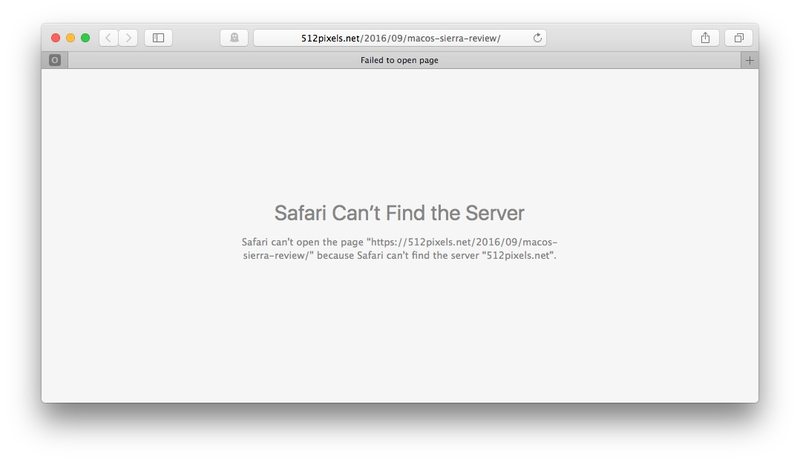
A quick side note: the “can’t find server” message can be due to wi-fi dropping, so if the connection difficulties are not limited to Safari you may want to use the wi-fi fix mentioned above.
Another odd variation of this is Safari failing to load webpages repeatedly, but after persistent refreshing, Safari may be able to successfully load a webpage but minus CSS (CSS being what styles the majority of webpages).
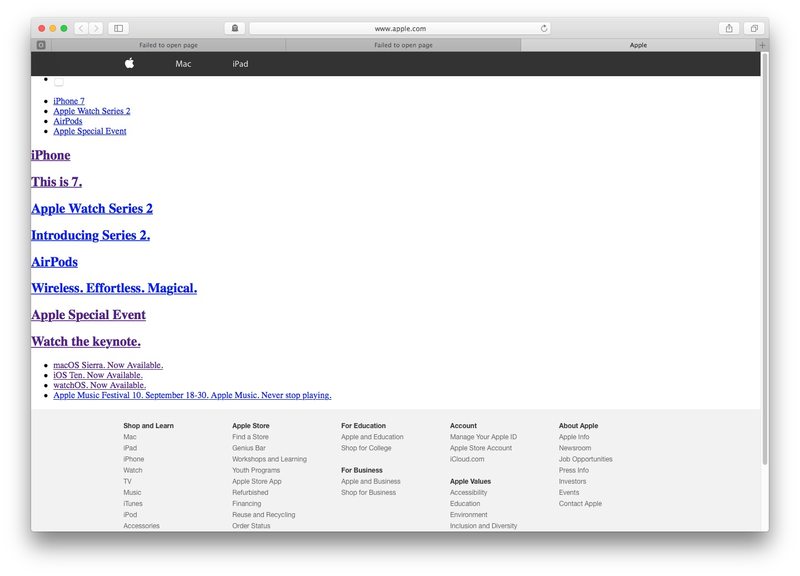
Additionally, another oddball Safari problem is when the browser URL bar and buttons vanishes entirely and no webpage loads at all.
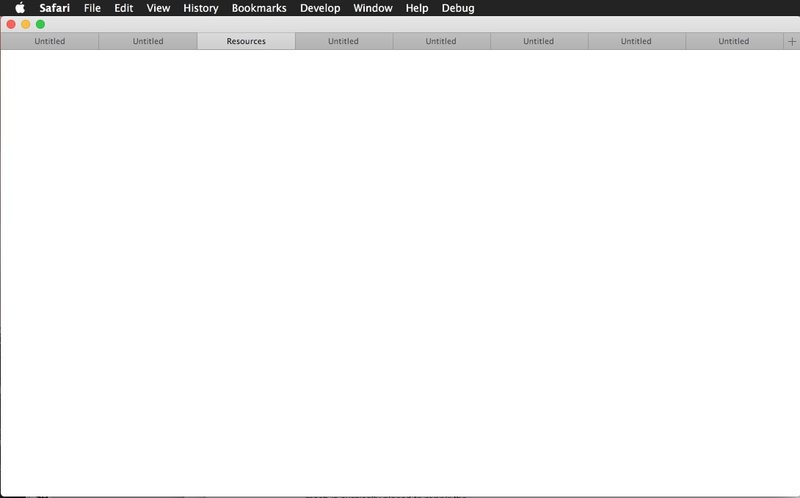
Sometimes quitting and relaunching Safari will remedy these issues, but usually you will need to reboot the Mac to get Safari working again for a while.
Another unusual error message you may encounter with Safari problems in macOS Sierra is an inability to load a webpage, where the tab or window renames itself to “Resources” and you get a blank page loading stating: “Your copy of Safari is missing important software resources. Please reinstall Safari.”

Since you can’t really “reinstall Safari” in macOS Sierra, the error recommendation is not particularly helpful, and instead you’ll likely want to reinstall all of macOS Sierra or revert to the prior Mac OS version from a backup.
Spotlight Doesn’t Work with macOS Sierra
Some users, myself included, have noticed that Spotlight just stops working entirely at random in macOS Sierra 10.12. Sometimes Spotlight will sort of half-work, but the results returned are completely inaccurate and don’t match the search term. This is not because of indexing, mdworker, or mds, however. You can kill the Spotlight process, it will spin back up, but the Spotlight search ability does not regain functionality.

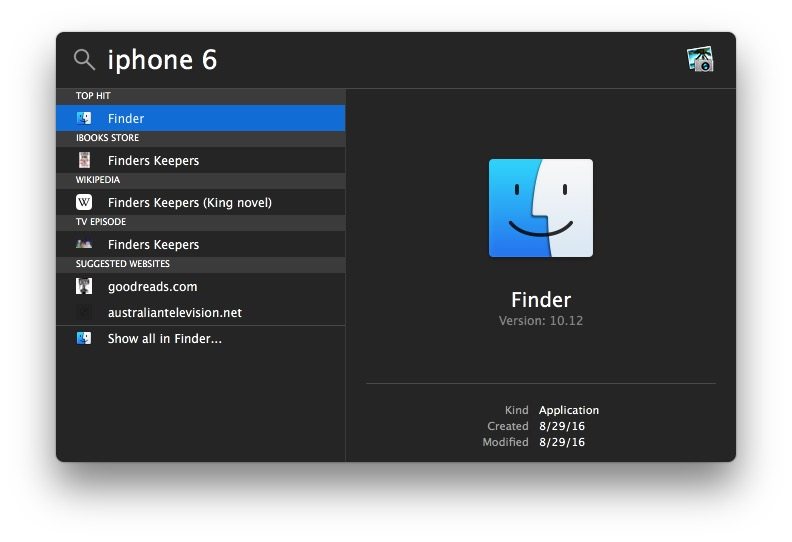
The only way to return Spotlight functionality in this situation is to reboot the Mac. Inconvenient, a bit Windows-esque, but it works.
You can also try to rebuild the Spotlight index directly, but you’ll still likely need to reboot the Mac to have Spotlight start working again as expected.
Mouse Not Working, Mouse Functionality is Erratic with macOS Sierra
Some users have discovered their mouse is not working at all, or the mouse may be working erratically after updating to macOS Sierra. For example, the scroll wheel functionality may become unresponsive or not work as intended. Some of these mouse issues have been narrowed down to Logitech and Razor brands, perhaps pertaining to drivers or software, but some of the erratic mouse behavior can occur with generic USB mice as well.
One possible fix for these issues is to connect the USB mouse directly into the Mac, rather than going through a USB hub.
Mac is Hot, Mac Fans Running at Full Speed After macOS Sierra Installation
If the computers fans are running after updating to MacOS Sierra and the Mac feels hot to the touch, it’s very likely to because the Mac is indexing. This is not indicative of a problem in and of itself, and it’s perfectly normal for the Mac to require reindexing the entire hard drive for features like Spotlight and Siri to work. Additionally, the new Photos app for Mac index the Photo library to identify places, features, faces and people, and other landmarks, which can also take a while. It’s also likely that Time Machine will be running to backup the Mac again after updating the system software. Just let all of these processes complete, do not intervene.
Thus, if the Mac is running warm or the fans are blazing away after updating to macOS Sierra, the best thing you can do is simply wait. The vast majority of the time the indexing process simply needs to run and complete, and the Mac will become usable with low fan usage and a cool temperature again.
For most users this process can take an hour or so, but with many documents or Photos, it can take quite a bit longer. If the Mac is still misbehaving after leaving it to index overnight, open the “Activity Monitor” application (found in /Applications/Utilities/) and sort by CPU, so that high CPU usage is at the top. This will tell you what (if any) applications or processes are consuming the processor and could give you an idea of where to look to troubleshoot further, which is typically an errant task or process.
macOS Sierra Video Problems, Hypercolor Rainbow Display Craziness
This is a weird one that I experienced on a Retina MacBook Pro: the built-in display suddenly encountered severe video display problems, ranging from improperly rendered drop-shadows to – and here’s where it gets really out there – psychedelic hypercolor rainbow display oddness, permeating throughout various onscreen elements.

In addition to the psychedelic color experience, dropshadows and other UI elements would appear obviously broken and display errantly:

Here’s a brief video demonstrating what the crazy video situation looks like on a Retina MacBook Pro display when it’s changing wallpapers:
<
The solution? Another SMC reset.
And yes, if you’re following along, that’s two different occasions where trouble after updating to macOS Sierra was resolved with an SMC reset…. hmm.
Finder Not Responding, Apps Crashing Constantly, Apps Won’t Open, Constant Beachballs
Finder not responding? Apps not responding? Apps won’t open? Apps say they are damaged? Constant inappropriate beachballs for no apparent reason? Well, you can temporarily remedy these issues by rebooting the Mac. And then rebooting the Mac again. And again.

But here’s the bad news if you are experiencing those type of issues consistently and have to reboot once or twice a day as a temporary workaround, you should give in and reinstall macOS Sierra.
![]()
Speaking from direct experience, I battled and troubleshooted for several days the unresponsive apps, apps unable to open, inappropriate beachballing, but no matter what I did, no matter how many caches and app data was trashed, whatever troubleshooting hoops I jumped through, the problems returned in a matter of time after the next reboot.
The only way to finally remedy these problems was to completely reinstall macOS Sierra via Recovery Mode. It takes a little while, but it seemed to have fixed the problem (for now anyway, knock on wood).
“The application ‘name’ can’t be opened” or Error -41
A variant of an aforementioned error message where apps don’t open is when the application reports a direct error message when trying to open, often in the form of an onslaught of error pop-ups stating “The application (name) can’t be opened” and sometimes accompanied by an “Error -41” message pop-up message. This seems to occur after macOS has
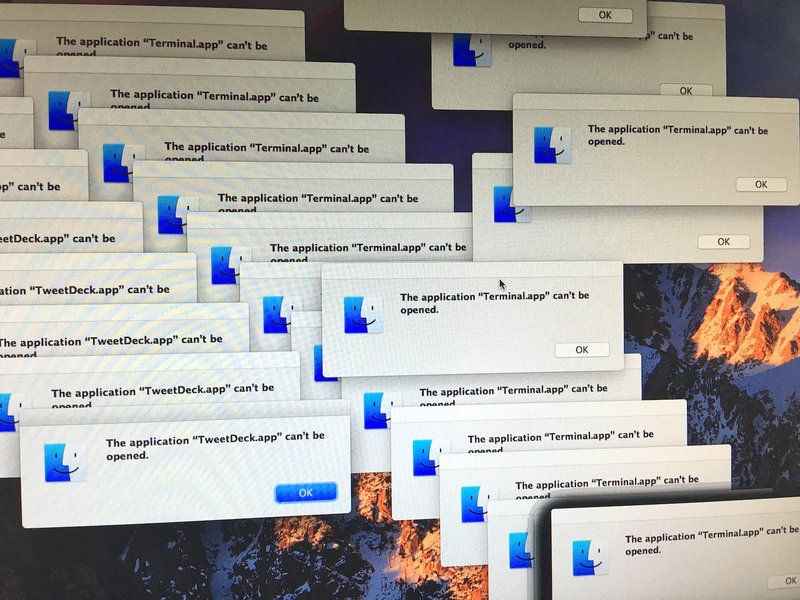
The only solution to this particular meltdown of macOS Sierra is to reboot the Mac. If you continuously experience this error or variations thereof it is likely a good idea to wipe the drive and clean install macOS Sierra.
Kernel “File: table is full” Errors Filling Console Log
On some user configurations, there appears to be a problem with Mac OS not properly closing files, though it is unclear what the cause or solution is. Eventually this can lead to “kernel file: table is full” errors flooding the Console log, requiring a manual forced reboot.
Time Machine Stuck “Preparing for Backup” in macOS Sierra
A fair amount of macOS Sierra users who rely on Time Machine for backups have discovered the Time Machine backup is perpetually stuck on “Preparing backup”. There are several possible reasons for Sierra and Time Machine to not work well together. One of the most common causes is a third party app, typically anti-virus software from Sophos or elsewhere, which seems to interfere with Sierra and Time Machine backups.
If you have Sophos Antivirus or any other Mac antivirus or similar scanning or “cleaner” software installed, disable it. Time Machine should resume backups once the software is disabled.
If you have disabled all antivirus software on the Mac and Time Machine is still not working in Sierra, try this fix for when Time Machine is stuck on preparing backup which involves disabling Time Machine and trashing a temporary file.
Sierra Bricked Mac Completely
A bricked Mac means it won’t boot up at all. This is very rare, but there are varying reports online of Sierra just outright bricking a Mac after a failed install.
If this happens, you’ll almost certainly need to initiate a reinstall process of macOS or Mac OS X, though some users have had to go so far as to take their computer to an Apple Store for hands-on support.
Troubleshooting Difficult macOS Sierra Problems
One of the best ways to troubleshoot some of the aforementioned unusual or more difficult Sierra problems is to create a separate Administrator user account on the Mac, and use that new separate account exclusively for a few days while performing regular computing activities. The reason for this is quite simple if the problem does not occur on a separate user account, it suggests the underlying cause is related to the other user account, perhaps in the form of a corrupt preference file or a process that is unique to that user account.
The key is to create a brand new user account, then log out of any other user accounts on the Mac. Only use the newly created user account as you attempt to reproduce the problem.
- Open System Preferences from Apple menu and go to “Users & Groups”
- Add a new user, named something obvious like “Troubleshooting” and set it as Administrator
- Log out of the existing user account (and log out of any other user accounts as well)
- Log into the newly created Administrator test account and try to reproduce the difficulty here

If the problem still occurs in the new user account, it suggests a deeper issue with the Mac OS systems software, an underlying system-wide process, or even the specific installation of MacOS.
Backing up thoroughly and then performing a clean install of macOS Sierra may offer a resolution or improvement to an issue that is reproducible from a new fresh user account.
If the problem returns after a clean install, there may be an outright bug with macOS, or there may be a problem with the Mac itself. If possible, contact the official Apple Support channels for further assistance. Downgrading macOS Sierra to El Capitan or Mavericks may offer a solution as well.
Disconnect Peripherals, Quit Apps, Try Again. Does the Problem Still Occur?
Another common troubleshooting technique for various issues is a process of elimination.
Try disconnecting all peripherals (except a mouse and keyboard if applicable). Does the problem no longer occur? If so, this could suggest some sort of issue with third party peripheral compatibility. It’s rare, but it does happen. Contacting the vendor who made the problematic peripheral may lead to a solution.
Next, try quitting all apps, and using each app one at a time. Does the problem still happen? Does the problem only happen with one specific app running, and not others? If so, this may be indicative of an issue with the specific app that is in use. Perhaps it needs to be updated to support Sierra, and contacting the developer of the app may be worthwhile.
The process of elimination works well in conjunction with the new user account method outlined before this. Sometimes it’s just a matter of narrowing down a problematic app, process, accessory, and sometimes that can only be done through trial and error.
Should You Wait for macOS Sierra 10.12.1?
It’s easy to read this article and conclude that macOS Sierra could be a pain-in-the-behind to deal with and troubleshoot. The good news is that the vast majority of users won’t experience any of these problems, most software updates go without a hitch.
Nonetheless, the difficulties described offer further evidence to support why you should always backup before updating any system software. Backing up is arguably the most important part of preparing for and successfully installing macOS Sierra (and any other OS for that matter), as it insures your data will be there in the event something goes wrong and you need to roll back or restore.
For me personally, updating a 2015 13″ Retina MacBook Pro to macOS Sierra from OS X El Capitan 10.11.6 has proven to be an unusual headache. As seen in this article, the problems have been pervasive and arrived as a deluge, with one issue appearing after the other. (For some background, I run a very vanilla and boring OS for my work machine with very few third party apps on this Mac). Ultimately I have reinstalled macOS Sierra and things are working more smoothly (at the moment anyway) but if the same variety of problems crop up again I’ll either perform a clean install or downgrade back to El Capitan and wait until 10.12.1 comes out (which is currently under beta development). Some Mac users routinely wait for the first major point release to install a major software update anyway. There’s certainly nothing wrong with that conservative approach to software updates, but obviously in the interim you’d be missing out on any of the great new features in macOS Sierra.
Anyway, what has your experience been with macOS Sierra? Did it go great or did you have any difficulty? Have you experienced problems afterwards? Did the troubleshooting methods outlined here help? Let us know in the comments.
